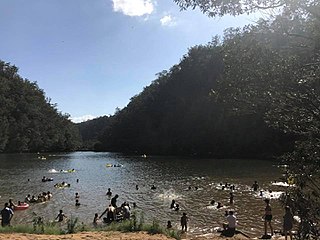
Conjola National Park covers 11,060 hectares and lies on the mid south coast of New South Wales, Australia, between Sussex Inlet and Lake Conjola, 165 km southwest of Sydney.

Myrtaceae or the myrtle family is a family of dicotyledonous plants placed within the order Myrtales. Myrtle, pohutukawa, bay rum tree, clove, guava, acca (feijoa), allspice, and eucalyptus are some notable members of this group. All species are woody, contain essential oils, and have flower parts in multiples of four or five. The leaves are evergreen, alternate to mostly opposite, simple, and usually entire. The flowers have a base number of five petals, though in several genera the petals are minute or absent. The stamens are usually very conspicuous, brightly coloured and numerous.
Ironwood is a common name for many woods or plants that have a reputation for hardness, or specifically a wood density that is heavier than water, although usage of the name ironwood in English may or may not indicate a tree that yields such heavy wood.

Bents Basin is a protected nature reserve and state park near Wallacia, New South Wales, Australia in the Sydney metropolitan area. The lake basin, which formed at the efflux of the Nepean River from the Hawkesbury Sandstone gorge, is a popular swimming hole with a camping area and an education centre used by local school groups. Also featuring a large woodland area and native wildlife, the reserve is the only picnic area along the Nepean River and it is one of the most popular water-based picnic parks in Greater Western Sydney.

Backhousia citriodora is a flowering plant in the family Myrtaceae, genus Backhousia. It is endemic to subtropical rainforests of central and south-eastern Queensland, Australia, with a natural distribution from Mackay to Brisbane. Other common names are sweet verbena tree, sweet verbena myrtle,, and lemon scented backhousia.

Backhousia is a genus of thirteen currently known species of flowering plants in the family Myrtaceae. All the currently known species are endemic to Australia in the rainforests and seasonally dry forests of Queensland, New South Wales and Western Australia.

Backhousia myrtifolia is a small rainforest tree species which grows in subtropical rainforests of Eastern Australia. First discovered and subsequently used by the indigenous communities of Australia, this plant produces oils that have a cinnamon-like aroma, and display both anti-bacterial and anti-fungal properties. Therefore, it has potential applications as not only a spice in food preparation, but also in the medical field as a treatment option for microbial infection. Backhousia myrtifolia can grow up to 30 metres. The leaves are ovate or elliptic, 4–7 cm long, and the flowers star-shaped in appearance.

Backhousia sciadophora is a common Australian tree, growing from near Dungog in New South Wales to near Kilcoy in south east Queensland. Common names include Shatterwood, Ironwood, Boomerang Tree and Curracabark. The habitat of Shatterwood is drier forms of rainforest in gorges and steep slopes, usually not on volcanic soils.

Eupoecila australasiae, commonly known as the fiddler beetle or rose chafer, is a colourful green- or yellow-and-black member of the scarab beetle family from eastern Australia.

Backhousia leptopetala is a common Australian tree, growing from Stanwell Park in the northern Illawarra district to near Buderim in south eastern Queensland.

Cryptophasa pultenae is a moth of the family Xyloryctidae. It is known in Australia from New South Wales and Queensland.

Lomatia myricoides, commonly known as the river lomatia, is a shrub native to New South Wales and Victoria in southeastern Australia.

Backhousia tetraptera is a tree in the family Myrtaceae. The only known population occurs at the foot of Mount Stuart near Townsville in Queensland, Australia.
Backhousia angustifolia, with common name narrow leaf myrtle, is a flowering plant in the family Myrtaceae, native to Queensland and northeastern New South Wales.

The Cumberland Plain Woodland is one of six main indigenous woodland communities of Sydney, New South Wales, Australia, that comprises an open tree canopy, a groundcover with grasses and herbs, usually with layers of shrubs and/or small trees. Situated in the Cumberland Plain, it is made up of dry sclerophyll woodlands, grasslands and/or forests, reminiscent of Mediterranean forests and temperate grasslands.












